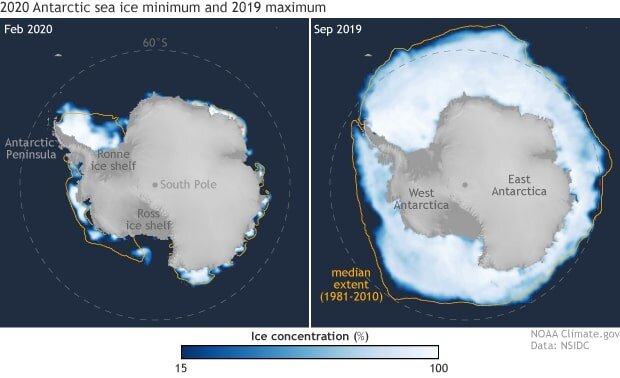https://www.scienceunderattack.com/blog/2021/3/8/growing-antarctic-sea-ice-defies-climate-models-72
We saw in the previous post how computer climate models greatly exaggerate short-term warming. Something else they get wrong is the behavior of Antarctic sea ice. According to the models, sea ice at both the North and South Poles should shrink as global temperatures rise. It’s certainly contracting in the Arctic, faster in fact than most models predict, but contrary to expectations, sea ice in the Antarctic is actually expanding.
Scientific observations of sea ice in the Arctic and Antarctic have only been possible since satellite measurements began in 1979. The figure below shows satellite-derived images of Antarctic sea ice extent at its summer minimum in 2020 (left image), and its previous winter maximum in 2019 (right image). Sea ice expands to its maximum extent during the winter and contracts during summer months.

But in contrast to the increase in the maximum extent of sea ice around Antarctica shown by observations during the satellite era, the computer models all simulate a decrease. Two research groups have investigated this decrease in detail for the previous generation of CMIP5 models.
One of the groups is the BAS (British Antarctic Survey), which has a long history of scientific studies of Antarctica dating back to World War II and before. Their 2013 assessment of 18 CMIP5 climate models found marked differences in the modeled trend in month-to-month Antarctic sea ice extent from that observed over the previous 30 years, as illustrated in the next figure. The thick blue line at the top indicates the trend in average monthly ice extent measured over the period from 1979 to 2005, and the colored lines are the monthly trends simulated by the various models; the black line is the model mean.

It’s seen that almost all models exhibit an incorrect negative trend for every month of the year. The mean monthly trend for all models is a decline of -3.2% per decade between 1979 and 2005, with the largest mean monthly decline being -13.6% per decade in February. But the actual observed gain in Antarctic sea ice extent is (+)1.1% per decade from 1979 to 2005 according to the BAS, or a somewhat higher 1.8% per decade from 1979 to 2019, as estimated by the U.S. NSIDC (National Snow and Ice Data Center) and depicted below.

For actual sea ice extent, the majority of models simulate too meager an extent at the February minimum, while several models estimate less than two thirds of the real-world extent at the September maximum. Similar results were obtained in a study by a Chinese research group, as well as other studies.
The discrepancy in sea ice extent between the empirical satellite observations and the climate models is particularly pronounced on a regional basis. At the February minimum, the satellite data indicate substantial residual ice in the Weddell Sea to the east of the Antarctic Peninsula (see the first figure above), whereas most models show very little. And the few models that simulate a realistic amount of February sea ice fail to reproduce the loss of ice in the Ross Sea adjoining West Antarctica.
All these differences indicate that computer models are not properly simulating the physical processes that govern Antarctic sea ice. Various possible processes not incorporated in the models have been suggested to explain the model deficiencies. These include freshening of seawater by melting ice shelves attached to the Antarctic ice sheet; meltwater from rain; and atmospheric processes involving clouds or wind.
BAS climate modeler Paul Holland thinks the seasons may hold the key to the conundrum, having noticed that trends in sea ice growth or shrinkage vary in strength in the different seasons. Holland surmised that it was more important to look at how fast the ice was growing or shrinking from season to season than focusing on changes in ice extent. His calculations of the rate of growth led him to conclude that seasonal wind trends play a role.
The researcher found that winds are spreading sea ice out in some regions of Antarctica, while compressing or keeping it intact in others, and that these effects begin in the spring. “I always thought, and as far as I can tell everyone else thought, that the biggest changes must be in autumn, Holland said. “But the big result for me now is we need to look at spring. The trend is bigger in the autumn, but it seems to be created in spring.”
That’s where Holland’s research stands for now. More detailed work is required to check out his novel idea.



